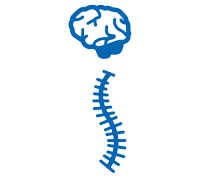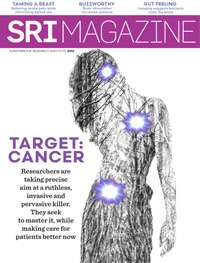
Q&A
Dr. Meaghan O’Reilly
Dr. Meaghan O’Reilly is a new scientist in the Physical Sciences platform and the Holland Bone and Joint Research Program at Sunnybrook Research Institute (SRI). She is also an assistant professor in the department of medical biophysics at the University of Toronto. She spoke with Alisa Kim about her research.

Illustration: Antony Hare
What excites you most about therapeutic ultrasound?
If we’re creative about it, we can focus ultrasound deep into the body, which we can’t do with most other wave energy. For example, you can have an ultrasound ablation or a radiofrequency (RF) ablation. In RF ablation, you have to insert an electrode somewhere to deliver the energy, but with the ultrasound ablation [which uses sound waves], we can apply it outside the body and direct it. If you look at trials where they’re doing ablation of these very small structures in the brain, instead of having to open the skull, treatment can be delivered through an intact skull so patients can go home the same or next day.
Why is it challenging to treat cancers of the central nervous system?
Right now, drug therapies don’t work well, if at all. Radiation in the spine is limited because dose limits are hit fairly quickly. Also, in the brain and spinal cord, we have the barriers of the central nervous system that prevent drugs from getting out of the vasculature and into the tissue.

Facts about leptomeningeal (lep-TOE-men-IN-gee-al) cancer:
- It occurs in the cerebrospinal fluid (CSF) and the membranes covering the brain and spinal cord.
- It usually arises from cancers of the breast, lung and gastrointestinal tract; and leukemia, lymphoma and melanoma.
- It occurs in 5% of people with cancer.
- Symptoms include seizures, pain, difficulty thinking and headaches.
- Median survival is two to three months.
How are you using focused ultrasound in the spine?
One of the studies I’m working on with [SRI scientist] Dr. Arjun Sahgal is to treat leptomeningeal (lep-TOE-men-IN-gee-al) tumours. This is late-stage, metastatic disease where tumour cells get into the cerebrospinal fluid and circulate in the fluid around the linings of the brain and spinal cord. They deposit on these linings and form long coatings of tumour. They’re thin, but large-surface-area tumours that compress the spinal cord and brain, so patients develop neurological complications very quickly and survival is short. There’s no good treatment. We’ve been looking at whether we can use ultrasound to enhance drug delivery to these tumours.
Why is focused ultrasound a promising way to treat cancer that has spread to the spine?
It’s noninvasive and nonionizing, which is important because that’s the limitation with radiation. One way to get drugs in is by direct injection. That can work for local tumours, but when you’re talking about something that can stretch for lengths of the spinal cord, you can’t imagine injecting at all these sites. Because focused ultrasound is nonionizing and noninvasive, we would be able to repeat treatments . Our preliminary preclinical work suggests there’s no issue with repeat treatments. If there’s a recurrence, patients could come back and have it treated again. It’s also the only technology that allows us to facilitate drug delivery without scarring the tissue from an injection site or other invasive procedure.
What do you look forward to in developing your research program at SRI?
I look forward to getting to know what the clinical research interests are. I’ve aligned with one of the programs [Holland Bone and Joint], but my research is in image-guided therapy, so that can be applied to cancer, musculoskeletal or brain. What I’m interested in, from an engineering and physics perspective, is how can we tailor these technologies for hard-to-treat conditions and hard-to-reach places?
O’Reilly’s research is funded by the Natural Sciences and Engineering Research Council of Canada.



